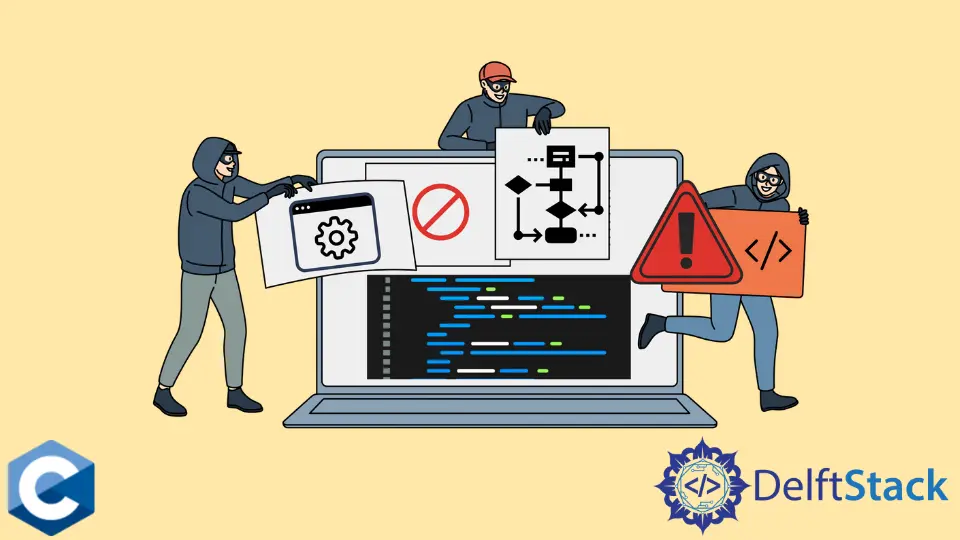Kill a Child Process em C
-
Use o sinal
SIGKILLpara encerrar um processo filho em C -
Use o sinal
SIGTERMpara encerrar um processo filho em C

Este artigo demonstrará vários métodos sobre como eliminar um processo filho em C.
Use o sinal SIGKILL para encerrar um processo filho em C
Existem vários sinais concebidos para terminar um processo na sua entrega, mas enviar o sinal SIGKILL é o método mais poderoso e seguro para o fazer. Geralmente, um programa pode registrar funções especiais chamadas manipuladores de sinal que são invocados automaticamente assim que o sinal correspondente é entregue ao programa. O usuário implementa o código de função do manipulador que geralmente realiza algum trabalho de limpeza para o programa. Além de manipuladores de função, pode haver ações padrão em sinais entregues, como bloquear e ignorar. Porém, o sinal SIGKILL não pode ser ignorado, bloqueado ou manipulado pela função fornecida. Portanto, este método deve ser o último recurso ao tentar encerrar um processo.
O sinal SIGKILL pode ser enviado com uma chamada de sistema kill. Observe, porém, que o manipulador SIGTERM registrado no exemplo de código a seguir não pode capturar o SIGKILL entregue e imediatamente mata o processo filho fornecido.
O programa a seguir gera um processo filho e registra o manipulador SIGTERM nele. Em seguida, o processo filho executa um loop infinito, a menos que o sinal seja entregue, o que inverte a variável de expressão while. Conseqüentemente, o sinal SIGKILL entregue pelo pai não invoca o manipulador e termina o processo filho instantaneamente.
#include <signal.h>
#include <stdio.h>
#include <stdlib.h>
#include <string.h>
#include <sys/wait.h>
#include <unistd.h>
volatile sig_atomic_t shutdown_flag = 1;
void cleanupRoutine(int signal_number) { shutdown_flag = 0; }
int main(void) {
int wstatus;
pid_t c_pid = fork();
if (c_pid == -1) {
perror("fork");
exit(EXIT_FAILURE);
}
if (c_pid == 0) {
printf("printed from child process - %d\n", getpid());
int count = 0;
struct sigaction sigterm_action;
memset(&sigterm_action, 0, sizeof(sigterm_action));
sigterm_action.sa_handler = &cleanupRoutine;
sigterm_action.sa_flags = 0;
// Mask other signals from interrupting SIGTERM handler
if (sigfillset(&sigterm_action.sa_mask) != 0) {
perror("sigfillset");
exit(EXIT_FAILURE);
}
// Register SIGTERM handler
if (sigaction(SIGTERM, &sigterm_action, NULL) != 0) {
perror("sigaction SIGTERM");
exit(EXIT_FAILURE);
}
while (shutdown_flag) {
count += 1;
}
printf("count = %d\n", count);
exit(EXIT_SUCCESS);
} else {
printf("printed from parent process - %d\n", getpid());
int ret;
sleep(5);
ret = kill(c_pid, SIGKILL);
if (ret == -1) {
perror("kill");
exit(EXIT_FAILURE);
}
if (waitpid(c_pid, &wstatus, WUNTRACED | WCONTINUED) == -1) {
perror("waitpid");
exit(EXIT_FAILURE);
}
}
exit(EXIT_SUCCESS);
}
Use o sinal SIGTERM para encerrar um processo filho em C
Alternativamente, um processo filho pode ser encerrado usando o sinal SIGTERM, que pode ser tratado pelo programa. O próximo exemplo de código repete a implementação do programa anterior, exceto que substitui o sinal SIGKILL por SIGTERM. A função sigfillset é usada para evitar que outros sinais interrompam a execução da função de tratamento registrada. O código do manipulador modifica a variável de tipo global sig_atomic_t que interrompe o loop while no processo filho e imprime o valor da variável count. Porém, lembre-se de que é sempre melhor usar a chamada sigaction acima da função signal ao registrar os manipuladores, já que esta última não é especificada em detalhes pelo padrão POSIX.
#include <signal.h>
#include <stdio.h>
#include <stdlib.h>
#include <string.h>
#include <sys/wait.h>
#include <unistd.h>
volatile sig_atomic_t shutdown_flag = 1;
void cleanupRoutine(int signal_number) { shutdown_flag = 0; }
int main(void) {
int wstatus;
pid_t c_pid = fork();
if (c_pid == -1) {
perror("fork");
exit(EXIT_FAILURE);
}
if (c_pid == 0) {
printf("printed from child process - %d\n", getpid());
int count = 0;
struct sigaction sigterm_action;
memset(&sigterm_action, 0, sizeof(sigterm_action));
sigterm_action.sa_handler = &cleanupRoutine;
sigterm_action.sa_flags = 0;
// Mask other signals from interrupting SIGTERM handler
if (sigfillset(&sigterm_action.sa_mask) != 0) {
perror("sigfillset");
exit(EXIT_FAILURE);
}
// Register SIGTERM handler
if (sigaction(SIGTERM, &sigterm_action, NULL) != 0) {
perror("sigaction SIGTERM");
exit(EXIT_FAILURE);
}
while (shutdown_flag) {
count += 1;
}
printf("count = %d\n", count);
exit(EXIT_SUCCESS);
} else {
printf("printed from parent process - %d\n", getpid());
int ret;
sleep(5);
ret = kill(c_pid, SIGTERM);
if (ret == -1) {
perror("kill");
exit(EXIT_FAILURE);
}
if (waitpid(c_pid, &wstatus, WUNTRACED | WCONTINUED) == -1) {
perror("waitpid");
exit(EXIT_FAILURE);
}
}
exit(EXIT_SUCCESS);
}
Founder of DelftStack.com. Jinku has worked in the robotics and automotive industries for over 8 years. He sharpened his coding skills when he needed to do the automatic testing, data collection from remote servers and report creation from the endurance test. He is from an electrical/electronics engineering background but has expanded his interest to embedded electronics, embedded programming and front-/back-end programming.
LinkedIn Facebook